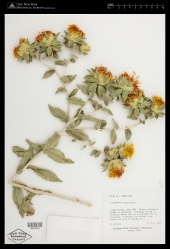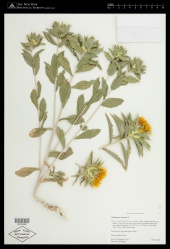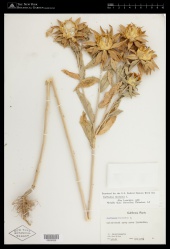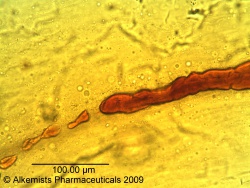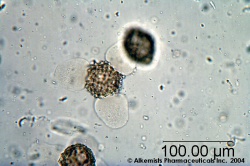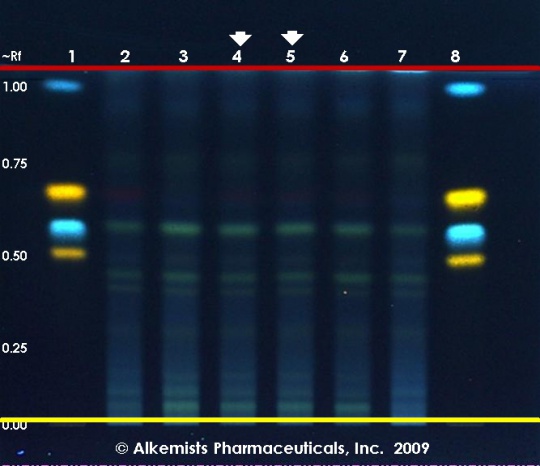Carthamus tinctorius (flower)
(add starr voucher specimens) |
|||
| (11 intermediate revisions by 3 users not shown) | |||
| Line 1: | Line 1: | ||
| − | = | + | {{DISPLAYTITLE:''Carthamus tinctorius'' (flower) }} {{askbox|herb=''Carthamus tinctorius''}} |
| − | =Macroscopic | + | =Nomenclature= |
| − | =Microscopic | + | {{nomenclature | binomial=Carthamus tinctorius |
| − | {{Microscopy | source=Elan M. Sudberg, Alkemist Laboratories | + | |authority=L. |
| + | |family=Asteraceae | ||
| + | |scn=safflower | ||
| + | |syn= | ||
| + | |ayurvedic=kusumbha | ||
| + | |pinyin=hong hua (flower) | ||
| + | |aka= | ||
| + | |notes= }} | ||
| + | |||
| + | =Botanical Voucher Specimen= | ||
| + | {{Media3 |cat=Voucher | ||
| + | |companyimage=Starr herbarium logo.png | ||
| + | | companyURL=http://sciweb.nybg.org/science2/VirtualHerbarium.asp | ||
| + | |mainimage=Carthamus tinctorius L. - Starr - 00505324.jpg | ||
| + | |caption1=''Carthamus tinctorius'' L. | ||
| + | |source=Images courtesy of the C.V. Starr Virtual Herbarium of the New York Botanical Garden | ||
| + | |companyimage2=Starr herbarium logo.png | ||
| + | | companyURL2=http://sciweb.nybg.org/science2/VirtualHerbarium.asp | ||
| + | |image2=Carthamus tinctorius L. - Starr - 00703082.jpg | ||
| + | |caption2=''Carthamus tinctorius'' L. | ||
| + | |source2=Images courtesy of the C.V. Starr Virtual Herbarium of the New York Botanical Garden | ||
| + | |companyimage3=Starr herbarium logo.png | ||
| + | | companyURL3=http://sciweb.nybg.org/science2/VirtualHerbarium.asp | ||
| + | |image3=Carthamus tinctorius L. - Starr - 00505329.jpg | ||
| + | |caption3=''Carthamus tinctorius'' L. | ||
| + | |source3=Images courtesy of the C.V. Starr Virtual Herbarium of the New York Botanical Garden | ||
| + | |}} | ||
| + | =Organoleptic Characteristics= | ||
| + | {| border=1 | ||
| + | | | ||
| + | {{Organolepsy | source=United States Dispensatory (1918) | ||
| + | | description=''Carthamus tinctorius'' L. ''Safflower''.— [...] has a peculiar, slightly aromatic odor, and a scarcely perceptible bitterness. }} | ||
| + | |} | ||
| + | =Macroscopic Characteristics= | ||
| + | {| border=1 | ||
| + | | | ||
| + | {{Macroscopy | source=United States Dispensatory (1918) | ||
| + | | description=''Carthamus tinctorius'' L. ''Safflower''.— The African, false, American, or dyers' saffron is an annual composite, with a smooth, erect stem, somewhat branched at top, and a foot or two in height. [...] The florets are in mass of a red color, diversified by the yellow of the styles contained within the floret. [...] It contains a fixed oil; also two coloring substances—one red, insoluble in alkaline liquids, and called ''carthamin'' or ''carthamic acid'' by Dobereiner, who found it to possess weak acid properties; the other yellow, and soluble in water. | ||
| + | }} | ||
| + | |} | ||
| + | =Microscopic Characteristics= | ||
| + | |||
| + | {{Media2 |cat=Microscopy | source=Elan M. Sudberg, Alkemist Laboratories | ||
| companyimage= AP-LOGO-Laboratories Crop - Copy.jpg | | companyimage= AP-LOGO-Laboratories Crop - Copy.jpg | ||
| − | | companyURL=http://www. | + | | companyURL=http://www.alkemist.com |
| mainimage=Safflower Alkemist Laboratories.jpg | | mainimage=Safflower Alkemist Laboratories.jpg | ||
| caption1=Fragment of the corolla showing brown laticiferous vessels observed at 400x with Acidified Chloral Hydrate Glycerol Solution. | | caption1=Fragment of the corolla showing brown laticiferous vessels observed at 400x with Acidified Chloral Hydrate Glycerol Solution. | ||
| description= Safflower (flower) (''Carthamus tinctorius'') | | description= Safflower (flower) (''Carthamus tinctorius'') | ||
| + | | source2=Elan M. Sudberg, Alkemist Laboratories | ||
| + | | companyimage2= AP-LOGO-Laboratories Crop - Copy.jpg | ||
| + | | companyURL2=http://www.alkemist.com | ||
| image2=Safflower-1 Alkemist Laboratories.jpg | | image2=Safflower-1 Alkemist Laboratories.jpg | ||
| caption2=Three pored pollen grain shown exuding contents observed at 400x with Acidified Chloral Hydrate Glycerol Solution. | | caption2=Three pored pollen grain shown exuding contents observed at 400x with Acidified Chloral Hydrate Glycerol Solution. | ||
| characteristics=cellular structures identified in this botanical specimen are fragment of the corolla showing brown laticiferous vessels and three pored pollen grain shown exuding contents when observed at 400x with Acidified Chloral Hydrate Glycerol Solution. | | characteristics=cellular structures identified in this botanical specimen are fragment of the corolla showing brown laticiferous vessels and three pored pollen grain shown exuding contents when observed at 400x with Acidified Chloral Hydrate Glycerol Solution. | ||
| + | | reference=Plant Drug Analysis, Wagner, H., 1996 | ||
| }} | | }} | ||
| − | =HPTLC | + | =High Performance Thin Layer Chromatographic Identification= |
| − | = | + | {{HPTLC | source=Elan M. Sudberg, Alkemist Laboratories |
| − | + | | description=Safflower (flower) (''Carthamus tinctorius'') | |
| + | | companyimage=AP-LOGO-Laboratories Crop - Copy.jpg | ||
| + | | companyURL=http://www.alkemist.com | ||
| + | | mainimage=Carthamus_tinctorius_-_Alkemist_Laboratories.jpg | ||
| + | | caption1=''Carthamus tinctorius'' HPTLC ID - Natural Product Reagent + PEG UV 365 nm | ||
| + | | stationaryphase=Silica gel 60, F254, 10 x 10 cm HPTLC plates | ||
| + | | mobilephase=ethyl acetate: AcCOOH: HCOOH: H2O [10/1.1/1.1/2.4] | ||
| + | | prep=0.3 g + 3 ml CH3OH sonicated + heated @ 50° C ~ 1 hr | ||
| + | | detection=Natural Product Reagent + PEG -> UV 365 nm | ||
| + | | lanes= Lanes, from left to right (Track, Volume, Sample): | ||
| + | # 1 μL Rutin, Caffeic Acid, Hyperoside, Chlorogenic Acid ~ 0.1% in Methanol | ||
| + | # 3 μL ''Carthamus tinctorius''-1 (flower) | ||
| + | # 3 μL ''Carthamus tinctorius''-2 (flower) | ||
| + | # 3 μL ''Carthamus tinctorius''-3 (flower) | ||
| + | # 3 μL ''Carthamus tinctorius''-3 (flower) | ||
| + | # 3 μL ''Carthamus tinctorius''-4 (flower) | ||
| + | # 3 μL ''Carthamus tinctorius''-5 (flower) | ||
| + | # 1 μL Rutin, Caffeic Acid, Hyperoside, Chlorogenic Acid ~ 0.1% in Methanol | ||
| + | |||
| + | Reference materials used here have been authenticated by macroscopic, microscopic &/or TLC studies according to the reference source cited below held at Alkemists Laboratories, Costa Mesa, CA. | ||
| + | |||
| + | | reference=Adapted from Plant Drug Analysis, Wagner, H., 1996 | ||
| + | | }} | ||
| + | |||
| + | |||
| + | =Supplementary Information= | ||
| + | =Sources= | ||
| + | <references /> | ||
Latest revision as of 18:28, 21 July 2015
Contents |
Nomenclature
Carthamus tinctorius L. Asteraceae
Standardized common name (English): safflower
Ayurvedic name(s): kusumbha
Pinyin name(s): hong hua (flower)
Botanical Voucher Specimen
|
|
|
|
Organoleptic Characteristics
|
Macroscopic Characteristics
|
Microscopic Characteristics
 |
 |
|
|
|
High Performance Thin Layer Chromatographic Identification
|
Safflower (flower) (Carthamus tinctorius) Lane Assignments Lanes, from left to right (Track, Volume, Sample):
Reference materials used here have been authenticated by macroscopic, microscopic &/or TLC studies according to the reference source cited below held at Alkemists Laboratories, Costa Mesa, CA. Stationary Phase Silica gel 60, F254, 10 x 10 cm HPTLC plates Mobile Phase ethyl acetate: AcCOOH: HCOOH: H2O [10/1.1/1.1/2.4] Sample Preparation Method 0.3 g + 3 ml CH3OH sonicated + heated @ 50° C ~ 1 hr Detection Method Natural Product Reagent + PEG -> UV 365 nm Reference see Adapted from Plant Drug Analysis, Wagner, H., 1996
|
Supplementary Information
Sources
- ↑ Images courtesy of the C.V. Starr Virtual Herbarium of the New York Botanical Garden http://sciweb.nybg.org/science2/VirtualHerbarium.asp
- ↑ Images courtesy of the C.V. Starr Virtual Herbarium of the New York Botanical Garden http://sciweb.nybg.org/science2/VirtualHerbarium.asp
- ↑ Images courtesy of the C.V. Starr Virtual Herbarium of the New York Botanical Garden http://sciweb.nybg.org/science2/VirtualHerbarium.asp
- ↑ United States Dispensatory (1918)
- ↑ United States Dispensatory (1918)
- ↑ Elan M. Sudberg, Alkemist Laboratories http://www.alkemist.com
- ↑ Elan M. Sudberg, Alkemist Laboratories http://www.alkemist.com
- ↑ Elan M. Sudberg, Alkemist Laboratories http://www.alkemist.com
